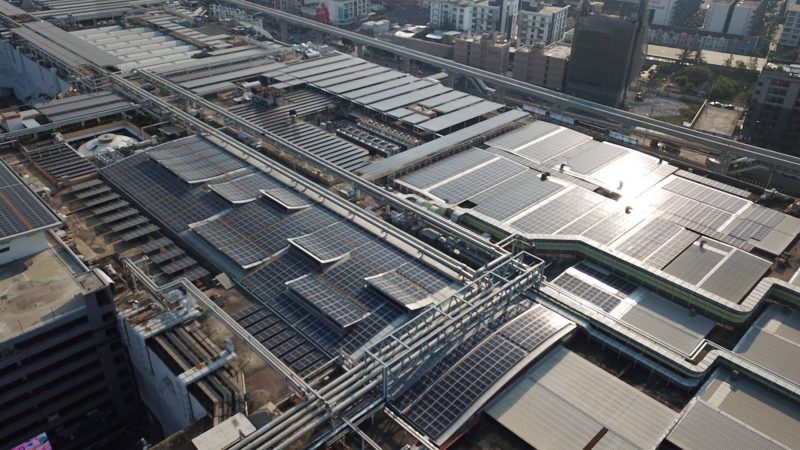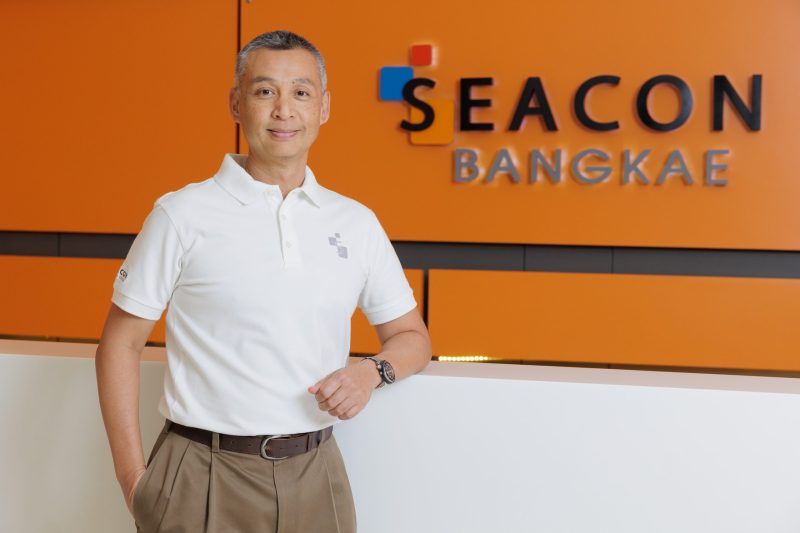Solar energy is the most abundant renewable natural resource that humanity currently has access to. In the era of Renewable Energy and a Green Future, more businesses and industries are embracing solar cell technology to convert sunlight into electricity, replacing conventional sources of electricity which have been experiencing increasingly high operating costs. These costs are significant for business operations in all industries. Whether it’s manufacturing, the service industry, or department stores, most businesses require a very high daily usage of electricity at their premises to accommodate customer needs. Because of this, digital power is becoming a game changer that many organizations have decided to invest in so that they can maximize abundant renewable energy resources to make their businesses more sustainable and to create a better quality of life for Thai people.
An outstanding success case is seen with Seacon Square Shopping Mall. Dr. Prote Sosothikul, Vice President of Operation Group for Seacon Development Plc., revealed the company’s success in utilizing clean energy for its Seacon Square Srinakarin and Seacon Bangkae malls: “For the past few years, we have been looking for new ways to reduce our expenses. When we looked at our operational costs, we found that our electricity bills were far higher than our other expenses, so we started to look for ways to reduce this cost. We started by converting all the light bulbs in our shopping malls to LED lights, but this could only lower our bills by so much. So we then turned to solar cell technology, which has been commonly used in many countries. As a result of this change, solar cell technology has helped Seacon Square Srinakarin save over 47 million baht a year on electricity, while Seacon Bangkae saved almost 2/3 of Seacon Square Srinakarin’s electricity bills.”
Dr. Prote explained that only 3 months after the installation, both malls were able to lower their electricity bills by as much as 15-17%. Encouraged by the results, the company is planning to install an additional 1MW solar array at Seacon Square Srinakarin, bringing total capacity to 6MW. Their solar cell installation plan also extends to other companies in the group such as Nanyang, Renaissance Phuket Resort & Spa, and Thaichuros. So far, their success in reducing electricity consumption is comparable to planting a hundred thousand trees. This success also demonstrates Seacon Development as a socially responsible business that is committed to protecting the environment and reducing its carbon emissions through technology that is in line with future sustainability trends.
“We want to be a good example. We believe that sooner or later others will follow in our steps. Other shopping malls and businesses are now interested in our solar energy project and are looking to learn from us. We always give full support to those who want to utilize and maximize solar power as it is very useful for everyone. Soon, more companies will opt to deploy solar batteries to store electricity for overnight use. This is an effective way to utilize natural energy while minimizing costs for organizations and society, especially for Thailand where there is sunlight everyday all year round.” Dr. Prote added.
He went on to explain how Seacon Development Plc. chose their solar cell solution, with the company having first spent a year studying the technology. The working team took overseas trips to learn from other countries, as well as to study inverter equipment, which converts DC electricity from solar cells to AC power. Eventually, the company settled on Huawei’s inverter hardware both for its high quality and having seen it be utilized in many European countries. Furthermore, its closed module design not only prevents dust and insects from getting in, but it can also handle Thailand’s high humidity, which can normally create harmful conditions for electronic equipment.
Dr. Prote explained further: “When we visited Huawei, their staff showed us that the equipment was still in excellent condition even after having been soaked in water or exposed to heat from spotlights. Our solar energy project is now the biggest one in Thailand and Southeast Asia, totaling 15,000 solar panels on 40-rai of roof space. Huawei’s solutions also help us to monitor and identify any ineffective or defective panels in real time and we can also check energy storage efficiencies from the sunlight.”
In addition to this, Huawei Technology (Thailand) Co., Ltd. together with Seacon Development Plc. have built a learning center at Seacon Square Srinakarin in which Huawei now showcases its inverters and provides solar cell knowledge for companies and organizations in Thailand, such as the Electricity Generating Authority of Thailand (EGAT) as well as schools and universities. The learning center aims to build basic knowledge of digital power and its technologies for all industries and sectors. Friendly staff are also on hand to help everyone understand how solar cell solutions work and the importance of choosing high-quality equipment with high safety standards before deployment.
Huawei and Seacon both share a mutual goal to create eco-friendly technology that will make the world a better place to live. As the world’s leading renewable energy solutions provider, Huawei has strong expertise in 5G, Cloud-based, and AI technology, which can be seamlessly integrated together with clean energy. Huawei is committed to supporting businesses and households in solar panel installation to increase renewable energy generation. Under Huawei’s mission to support 30,000 solar panel projects within the next three years, it is expected that Thailand could reduce over 265,000 tons of carbon. As a leading green solutions provider, a leading ICT partner, and a digital transformation contributor, Huawei is committed to creating innovation and supporting the use of renewable energy through partnerships with governments and industry partners in order to make the world a better place for everyone. Huawei is more than ready to support every organization and party to easily access digital power technologies and to maximize natural energy while helping tackle global warming risks through smarter ways, which can in turn lower costs and expenses for organizations through sustainable technologies.
Source: Carl Byoir & Associates

